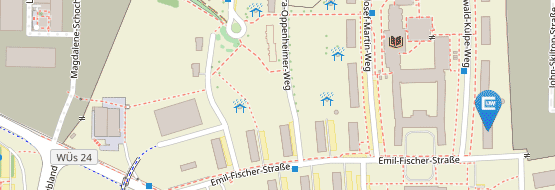Project Work Group Discussion
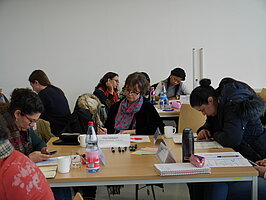
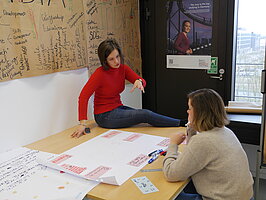
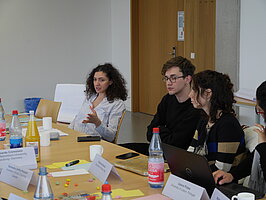
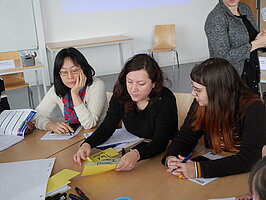
Setting
Room
Type and name of the course, curriculum, number of students
- Master’s degree in adult education, lifelong learning and pedagogical sciences, course in the methodology of education research
- The students regularly attending the class (around 50)
Aim of the strategy/method
- To develop critical thinking, communication, and teambuilding skills
Description
- Groups of 4 to 6 students are formed who are asked to express their intentions freely with peers on a topic they have chosen (project work) or that has been assigned by the teacher/instructor/facilitator.
- The task ‘project work’ introduces students to the rigour of scientific research and to the variety of research methods and strategies. It further helps students improve their skills in reading texts and documents (may not be required in some cases) with the goal of making them responsible for a documented group oral presentation on a topic related to the class attended (methodology of research or general pedagogy) and for preparing and leading a related classroom discussion.
- The teacher gives students up to 30 minutes (if the strategy is used as an in-class exercise) or up to 1 month (as homework) based on the complexity of the assigned task.
- Active participation is required of each group since everyone has to contribute to the work. If the assignment is to be accomplished in class, no evaluation is provided by the teacher but tips to improve and secure the learning. If one of the assignments is due for the final evaluation, then the evaluation will be provided by the teacher.
- At the end of the group work, all members are asked to show the product/products of their work (usually a poster) to the other groups. That means that each participant should present at least a part of the work process.
- The task is completed if each student is able to explain the planning and preparation of the work and the knowledge acquired, using coherent and scientific language and adopting the right body language, feeling self-confident and standing. Each group member should be able to answer the questions by the teacher.
- Possibly a peer evaluation (among the groups or among the team members)
Materials required
- Posters, post-it notes, pencils, markers, felt-tip pen, paper
Origin and theoretical framework
- Student-centred learning and teaching methods#
Risks and advantages
- Advantages: active engagement in the learning process, meaningfulness of the learning experience, team building skills, peer evaluation
- Risks: may be difficult for some students more used to teacher-centred learning; the teacher needs to be as clear and precise as possible when explaining the tasks assigned to students
Possible Variations
- International Winter School of Wurzburg (COMPALL project) in the years 2015-2018
- International Summer School of Belgrade 2016 (ESRALE project)
Other examples where you think it could be used
- The peer evaluation process and the team/group work could be applied to any kind of training activity, in traditional classrooms (didactics) or in the training activities offered by job placement services (third mission) offered to students, graduates, PhD students, or non-traditional students
Note: On the link among group discussion, critical thinking and communication skills.
Critical thinking skills may be acquired in:
- reading (and re-reading, by exchanging points of view on the meaning of the case study),
- discussion (identification of main facts, main actors, main issues to be solved or identification of needs)
- idea generation (students elaborate ideas and solutions based on the needs analysis)
- analysis (students try to answer the questions posed by the teacher, who aims to guide students in solving the assignment)
- presentation of the case study.
This means critical thinking skills are acquired in each phase of the ‘case study work group’ practice.
Example #1: Becoming aware that multiple divergent and convergent questions may exist on the same case study can promote high-level reasoning skills in students.
Example #2: Exploring real problems, through on-field interviews, can enhance students’ understanding of deep needs. The project design would be supported by the ability to tune the process with people’s aims.
Following this, the elaboration of educational actions reflects the grounded exploration of concrete situations and could bolster students’ capability to think outside the box.
When the teacher/facilitator supports students in their learning process by interchanging ideas, then critical thinking skills can improve. The same is true of the final common presentation, when teachers question students about their work.
Please note that critical thinking is understood as follows: ‘Critical thinking is the ability to identify, analyse and evaluate situations, ideas, and information in order to formulate responses to problems’ (World Economic Forum, 2015: p- 3).
The model we adopt when trying to strengthen students’ critical thinking skills is the ‘design thinking’ model developed by Hasso Plattner at the Institute of Design at Stanford, also known as the Stanford d-school.
Although there are many other design thinking models (e.g. IDEO, Google Design Sprints, Austin Center for Design, etc.), we decided to adopt the above-mentioned model from the Stanford d-school because it focuses on the empathetic approach and interviewing as a technique for needs analysis.
As a matter of fact, in order for the model to be empathic, it needs to include actions that have an embedded pedagogical added value and direct connectivity with our epistemological vision of research. These actions are:
- immerse: experience the users’ experiences (in our case, the interviewed persons);
- observe: view users (in our case, the interviewed persons) and their behaviour in the context of their lives (the reasons for their decisions and the environment in which they behave);
- engage: interact with and interview users (the interviewed) and ‘intercept’ their needs.
At the same time, the model considers empathy and the deep understanding of people the foundations of this human-centred design process.
To be able to design ‘for’ people with empathy implies the urgent need to understand them in depth, that is, to understand:
- expressed needs;
- latent needs;
- the deep meaning of what they say (verbal and non-verbal aspects of communication):
- past experiences.
To design ‘for’ people with a deep understanding of the people means to be able to answer questions such as ‘what’ and ‘how’ before being able to answer the ‘why’ question.
Only through empathy and deep understanding will it be possible to analyse the real needs of people. Certainly, this implies the idea of human action as the action of a human being who is behaving according to the ‘being human’ principle.
Communication skills can be acquired by:
- sharing ideas with the team members to reach a shared decision regarding the content and the final presentation.
The evaluation process (peer feedback), which requires very high attention to the use of words, should be based on a real situation, on facts, not on the people
References
Austin Center for Design, https://www.ac4d.com/ (12/2020)
Google Design Sprints, https://design-sprint.com/google-ventures-design-sprint/ (12/2020)
Hasso Plattner of the Institute of Design at Stanford, https://engineering.stanford.edu/get-involved/give/hasso-plattner-institute-design (12/2020)
IDEO, https://www.ideo.com/eu (12/2020)
Standford d.School, https://dschool.stanford.edu/ (12/2020)


